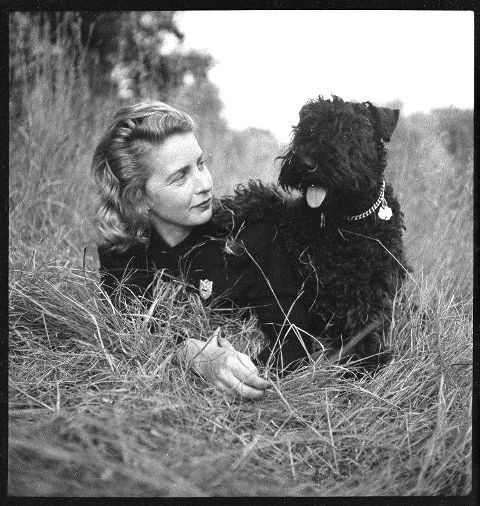
In February 1966, the demolition of several old apartment buildings and a church on York Avenue between East 71st Street and East 72nd Street revealed a cobble court with a very tiny frame house — believed to be an 18th-century farmhouse — that had been hidden from public view for about 75 years.
It was in this little house on the cobble court that Margaret Wise Brown, author of such children’s classics as Goodnight Moon and The Runaway Bunny, wrote what turned out to be her very last book.
Inspired by her pet terrier, Crispin’s Crispian, Mister Dog: The Dog Who Belonged to Himself is about a conservative dog who goes looking for a friend. The book was illustrated by Garth Williams (of the Little House books and Charlotte’s Web fame), who no doubt used the little house on York Avenue as the model for Margaret’s fictional dog (as you’ll see later in this old New York story).
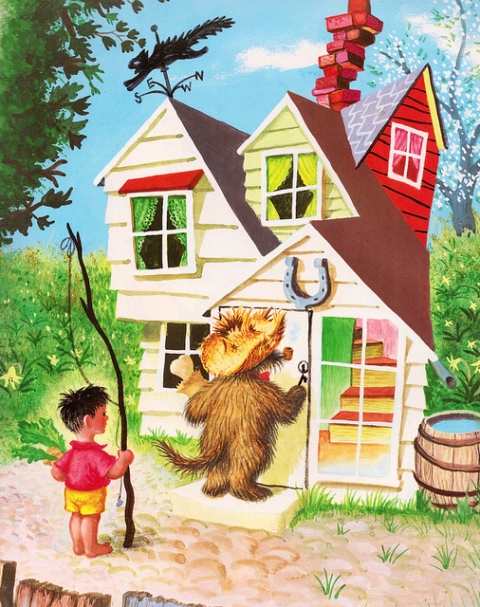
Much has been written about the Brooklyn-born Margaret Wise Brown and her career, so I’m going to jump right to the history of this little house on the cobble court, where she spent just a brief time during her incredible career as one of America’s most favorite authors of children’s picture books.
Part I: The Old Louvre Farm
“It was the last fastness of the forest primeval that once covered the rocky shores of the East River, and its wildness was almost savage.”–Early account of the area known as Lenox Hill
In Part I, we go way back in time to when the area we know today as Lenox Hill on the Upper East Side of Manhattan was a dense and spooky forest situated on the bluffs overlooking the East River and located far, far away from the city proper.
It was here in a clearing that one could find a farm of about 90 acres that extended from the Old Boston Post Road (near today’s Third Avenue) to the East River between present-day 66th Street and 75th Street.
Our story of Crispin’s Crispian and the little frame house on the cobble court that he shared with Margaret Wise Brown takes place on the west side of Avenue A (today’s York Avenue) between 71st Street and 72nd Street, also known as Lot 4 of the Louvre Farm subdivision of 1855.
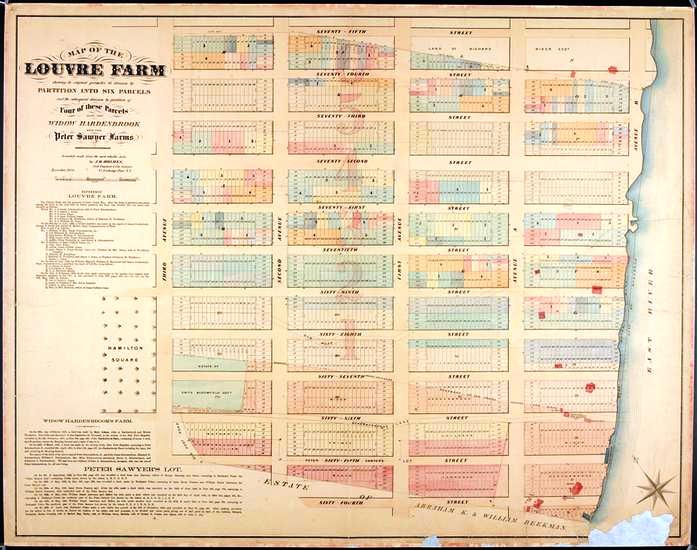
We start on October 9, 1677, when Sir Edmund Andros, the governor of the Province of New York, granted about 60 acres to John Bassett and 30 acres to Cornelius Mattyson. Over the next 100 years, the 60-acre plot was conveyed from Bassett to William Green, to William Hallett, and to George Hallett. The 30-acre plot was conveyed to Johannes Peterson and then to George Hallet.
In 1727, Hallett conveyed the entire 90-acre farm to Abraham Lameter, who in turn sold the land to David Provost on September 11, 1742.
Provost, a New York City merchant and privateer, was extremely wealthy and thus known as Ready-Money Provost (there were rumors that he hid his money in a cave on the farm near the East River). He built a large country mansion near the river, smack in the middle of what would become East 69th Street. He called his estate the Louvre Farm.
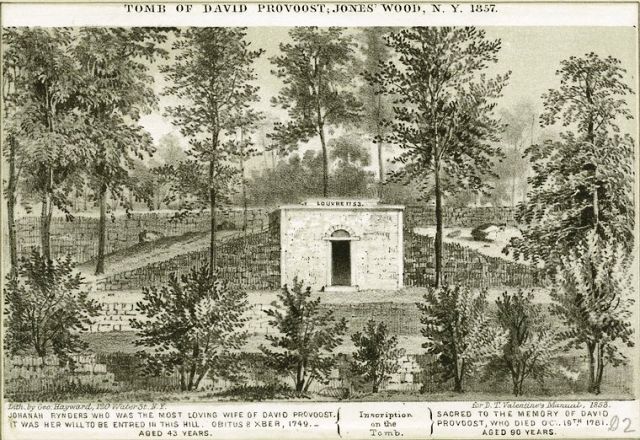
On December 6, 1777, David Provost gifted the 90-acre farm to his former housekeeper and second wife, Sarah Bolton Loftus. Ten years later, in 1787, Sarah conveyed the property to James Provost, David’s grandson. James in turn conveyed equal parcels of the property to his seven siblings (keeping one parcel for himself). Sometime around this point, a little frame farmhouse on a cobble court was constructed.
Jones’ Woods
Sometime around 1800, a successful innkeeper and merchant by the name of John Jones purchased the land from the Provost siblings in order to have a country seat near New York. (The Provost house became his country seat.) After his death in 1806, the farm was divided once again into lots among his children: Sarah Schermerhorn (wife of Peter Schermerhorn), James I. Jones, John Jones, Isaac Colford Jones, Frances M. Pendelton, and William H. Jones.
In time, the old Louvre Farm became known as Jones’ Woods.

In 1853, following a long debate, an act was passed in favor of creating Central Park by a vote of 12 to 10. The act authorized the purchase of the land (eminent domain) lying between 3rd Avenue and the East River from 66th Street to 75th Street.
Much opposition arose, especially because the land was inaccessible and bounded on one side by the swift current of a deep stream (some nearby property owners were in favor of the park, as they believed it would raise their property values). In the end, the Jones’ heirs refused to sell the land.

The act was repealed on March 6, 1854. A year later, the Jones’ siblings leased a small portion of their land (400 lots between 66th and 69th streets) for use as a public picnic ground. The northern portion, from 69th to 75th Street, was advertised for residential development.
Jones’ Wood, as the picnic grounds were called, has been called “America’s first amusement park.” It featured attractions such as billiards, bowling, a shooting gallery, donkey rides, dancing, concerts, hobby horses, and much more. (During the Civil War, the land was used extensively by the military.) There was a large coliseum near Avenue A between 68th and 70th streets, a shooting range on 70th Street, and a platform for outdoor dancing also near 70th Street.

The old Provost mansion became the Jones’ Wood Hotel under the proprietorship of Valentine Mager (pronounced Major), who leased the land from 1858 to 1860.
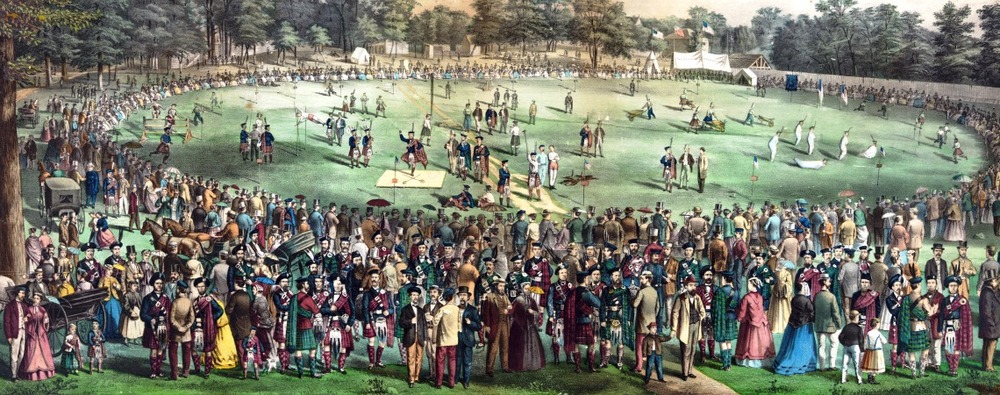
In 1857, the only public road that traversed through Jones’ Wood was Second Avenue. However, Avenue A was under contract at this time, and cherry trees were beginning to be felled for development (an old newspaper account noted that the sunshine could be seen for the first time). Several streets were opened, including 65th, 66th, 71st, and 74th streets.
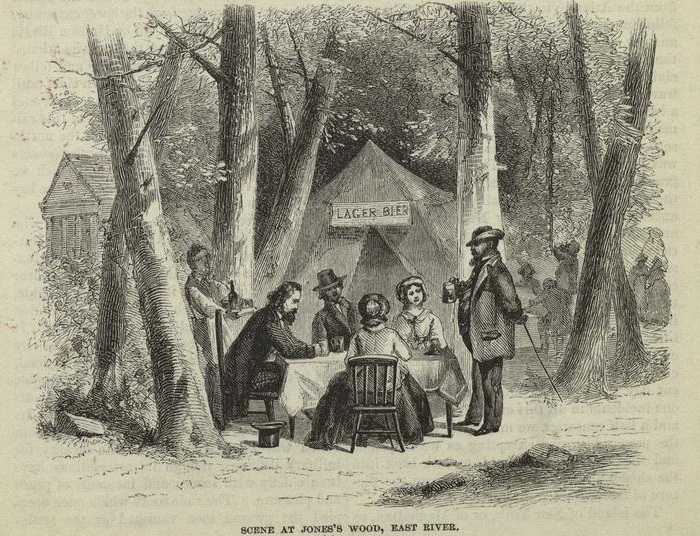
During the 1860s and 1870s, Jones’ Wood was the resort of working-class New Yorkers, who traveled by excursion steamers and the horsecars on Second and Third Avenue to enjoy beer, athletics, and other rowdy entertainments that were banned in Central Park.
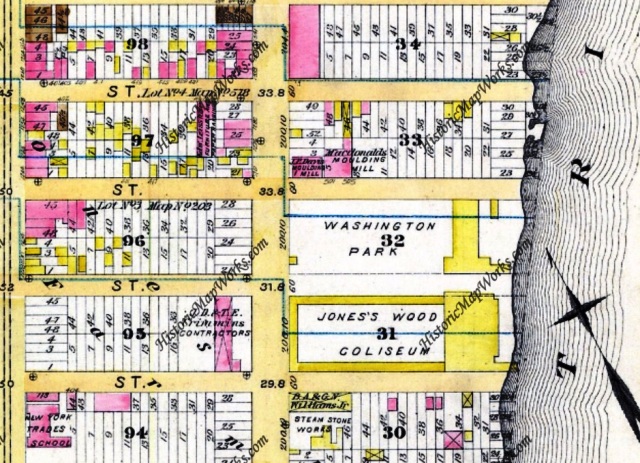
In 1872, John F. Schultheis became the proprietor of Jones’ Wood Park. He erected his “Coliseum” about 1874 (it had seating for 14,000 spectators), and to the north, he established a second picnic ground called “Washington Park.” By this time, the old Provost mansion, aka the Jones’ Wood Hotel, although still occupied by Schultheis, was a dilapidated ruin.
On May 16, 1894, at about 4:30 a.m., a fire broke out in the kitchen of the Coliseum, near the northeast corner of the building, which was very close to the old Provost mansion and Schultheis’ horse stables. Although the fire was contained to the east side of Avenue A, it destroyed almost everything on about 11 acres of land. When the fire was out, the only things left standing were the kitchen chimney and a merry-go-round.
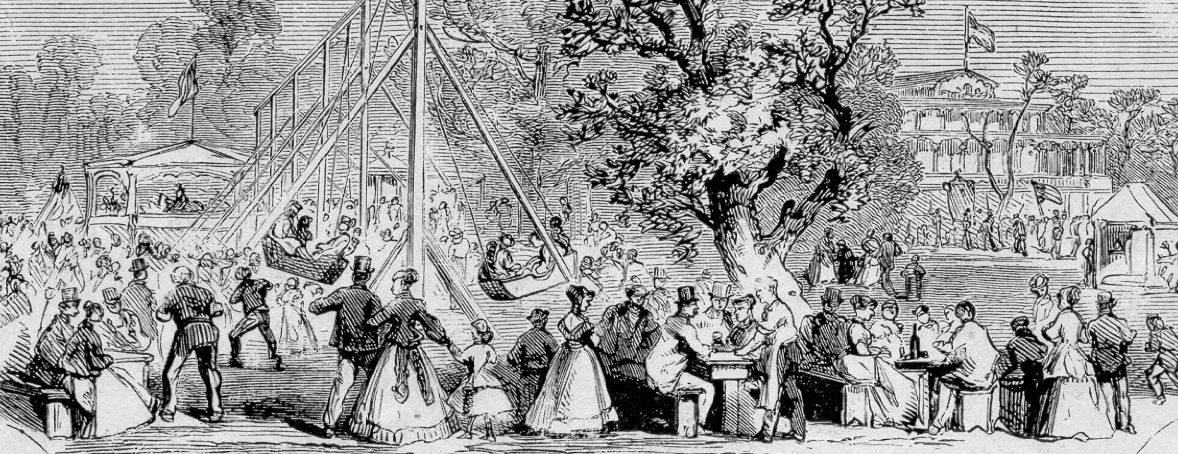
In Part II, we’ll return to 1868, which is when William Glass purchased a couple of lots for his dairy operation on Lot 4 of the old Louvre Farm. It was here that Glass built a new brick home in front of the tiny frame house on the cobble court…




[…] Part I of Crispin’s Crispian, we left off in 1894. In Part II, we go back just a bit to the 1860s, which is when William and […]
Thank you for this very comprehensive history of Cobble Court & Mr. Dog, Crispin’s Crispian.I live just two blocks from it’s present day location & since 1989 when i moved here, I have visited it regularly because it is so unique. For the last several years, I have been trying to piece together the story from info online, but this surpasses what I have been able to find. “Mister Dog” is still in print, so I gave it to my Great Niece for her birthday one year along with the story of Margaret Wise Brown. You may know that in 2014 Suri Bieler, the current owner, put the site on the market as a development site at $20 million. As far as I know, nothing has happened yet, it is landmarked & Villagers would fight to keep it. Last year, when I was walking by one day, I noticed a new Mr. Dog, an American Bulldog, looking out the door of Cobble Court, so I photographed him. He was very sweet, he may have just been visiting… I have enjoyed some of your other stories as well & will be following you, you do a great job!
I’m so glad you enjoyed this story — it’s my favorite story tell when I take my blog on the road at libraries. Do you still have the picture of the new Mister Dog? I’d love to add it to my post! I did read about the proposed development for the site, and I hope that this will never happen. We have enough condos in the city but not nearly enough little cottages!
Thanks for replying to my comment I do have the photos of Mr. Dog. He is just peeking out of his doggy door. I have a close up & one that includes the Cobble Court house. I didn’t go close enough to stick my camera through the fence, because I felt that would be too much of an intrusion. I can send them to you & you can see what you think. If you publish them, please give me photo credit.
Just let me know how you would like me to send them. So happy ai found your blog, can’t wait to read more of your stories.